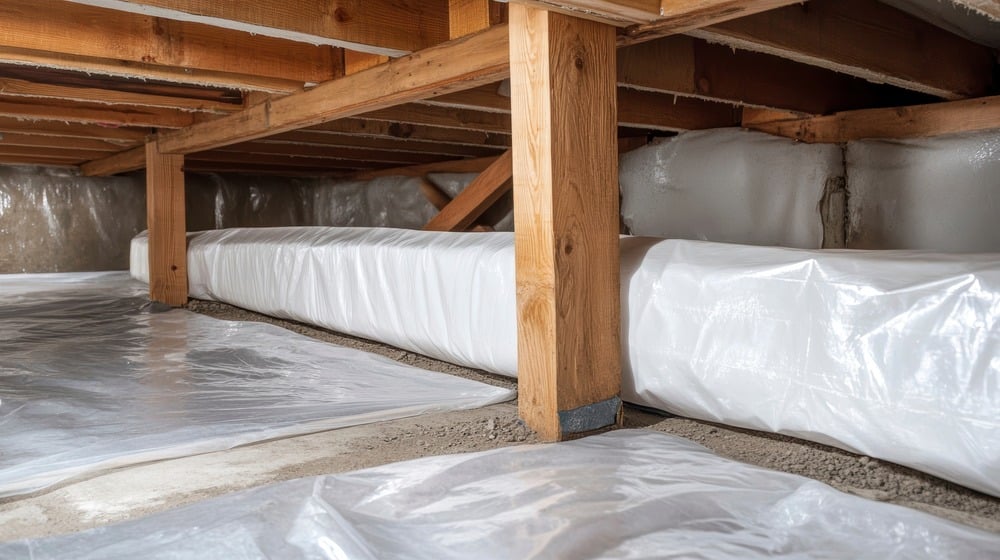
If you have ever dealt with moisture issues in your home, you know how frustrating and damaging it can be. Water is a quiet threat to your home’s structure, comfort, and air quality. One of the most effective ways to control this problem is by installing a vapor barrier. But what exactly is it, how does it work, and where should it be installed? We will talk about it all in this blog post.
How Moisture Affects Homes?
Moisture can quietly cause severe damage if left unmanaged. Here is how it affects your home and why vapor barriers are often necessary:
- Promotes mold and mildew growth, which compromises air quality and can lead to health issues
- Weakens structural materials like wood and insulation over time
- Causes paint and wallpaper to peel off or bubble due to trapped humidity
- Triggers unpleasant odors in basements, crawl spaces, and closed-off areas
- Increases energy costs as excess humidity makes your HVAC system work a lot harder
What Is a Vapor Barrier?
A vapor barrier is a material used to slow or block moisture from passing through walls, floors, or ceilings. It is a protective layer that prevents water vapor from migrating into your living spaces, where it can directly cause damage or mold growth. They are typically made from polyurethane sheets and are strategically installed based on your home’s construction and climate conditions.
Where Vapor Barriers Are Installed?
The location of a vapor barrier depends on where moisture intrusion is most likely to occur in your home. The most common places include crawl spaces, basements, and wall or attic assemblies.
Crawl spaces
In vented or unsealed crawl spaces, moisture from the ground can easily rise and infiltrate your subfloor. Vapor barriers are placed over the floor and walls to create a continuous barrier that seals off the crawl space from the outdoors.
Basements
Basement walls and floors are vulnerable to moisture seepage, especially in older homes or areas with high water tables. Vapor barriers can be installed along the walls or under flooring systems to prevent vapor from entering your basement.
Walls and Attics
Vapor barriers help reduce condensation from warm indoor air meeting cooler surfaces. They are installed on the warm side of the insulation, typically the interior-facing side in cold climates.
Types of Vapor Barriers
There are different kinds of vapor barriers, categorized by the material used and their ability to resist vapor transmission.
By Material
- Polyethylene plastic sheeting comes in various thicknesses. The thicker the sheet, the more durable and resistant it is to tearing.
- Foil-facing insulation provides both insulation and vapor resistance in one product. It is often used in walls and attic spaces.
- Vapor-retardant paints and coatings are applied to interior walls where traditional barriers may not be suitable. These are useful in remodeling projects or retrofits.
By Permeability Rating
- Class I: Impermeable materials like polyethylene and foil with very low permeability ratings. These are best for areas with high moisture levels.
- Class II: Semi-permeable materials that slow vapor movement but still allow some drying.
- Class III: Permeable materials used in assemblies that require drying in more than one direction. Examples include latex paint over gypsum board.
How Do Vapor Barriers Work?
Here’s how vapor barriers work for your home:
Blocking vs. Retarding Moisture
Vapor barriers function by either blocking moisture entirely or slowing its progress. The goal is to stop water vapor before it can condense on cool surfaces and cause issues. In areas like crawl spaces, complete barriers are needed to keep moisture from the soil out of your home. In wall assemblies, semi-permeable materials are used to manage indoor humidity while still allowing some drying.
Placement Matters
Where you install the vapor barrier makes a significant difference. In cold climates, they are usually installed inside the insulation to prevent warm air from reaching cold exterior walls. In warm climates, they are installed on the exterior side to stop humid air from entering cooled indoor spaces. Putting a vapor barrier in the wrong spot can trap moisture and make the situation worse instead of better.
Vapor Barriers in Crawl Spaces
Vapor barriers are extremely useful in crawl spaces for the following reasons.
Why Crawl Spaces Need Vapor Barriers?
Crawl spaces are particularly vulnerable to ground moisture. Without a barrier, water vapor rises from the soil, leading to high humidity, wood rot, and mold growth beneath your home. This excess moisture can spread through your entire house, compromising your air quality and driving up your utility bills.
Crawl Space Encapsulation vs. Basic Vapor Barriers
Encapsulation involves sealing the entire crawl space, including the walls, vents, and floors, with a reinforced vapor barrier and adding a dehumidifier for complete climate control. A basic vapor barrier only covers the floor and is less effective over time. Encapsulation is a long-term investment that provides stronger protection for your crawl space.
Common Myths and Misconceptions
Now, let’s debunk some common myths and misconceptions surrounding vapor barriers:
All homes need vapor barriers.
Not every home requires a vapor barrier. Climate, insulation type, and construction methods all influence whether a barrier is necessary. A professional can evaluate your home and determine if one is appropriate for your house.
Thicker is always better.
Thicker materials may be more durable, but they are not always the right choice. The effectiveness of a vapor barrier usually depends on the placement, installation quality, and compatibility with your home’s conditions, not just thickness.
Vapor barriers are the same as waterproofing.
Waterproofing deals with liquid water and keeps it out of your home. Vapor barriers deal with moisture in the form of vapor. While they both manage moisture, they serve different roles in your home’s protection system.
Benefits of Using Vapor Barriers
Vapor barriers come with numerous benefits for your home. Some of these benefits include:
Protects Structural Integrity
By keeping moisture away from the wood and metal framing in your home, vapor barriers help maintain the strength and stability of your home’s structure.
Prevents Mold and Allergens
Moist environments are the best breeding grounds for mold, mildew, and dust mites. Vapor barriers reduce humidity, creating a healthier living space for you and your family.
Enhances Energy Efficiency
A home with controlled humidity is easier to heat and cool. Vapor barriers help maintain a steady indoor environment, so your HVAC system does not have to work overtime.
Improves Indoor Air Quality
When you control the moisture levels beneath and inside your home, you reduce airborne pollutants. This results in cleaner and healthier air and fewer allergy triggers.
Increases Property Value
Moisture problems can drag down your home’s resale value. A properly installed vapor barrier adds to your home’s appeal by preventing future issues and tells buyers that the property is well cared for.
Key Takeaways
Vapor barriers may not be the flashiest home improvement project, but they play a vital role in protecting your home from the unseen damage caused by moisture. These barriers keep your air cleaner, your structure stronger, and your energy bills lower. By understanding how vapor barriers work and where they are most effective, you can make informed decisions for your home’s long-term health. At KC Waterproofing and Foundation Repair, we take the time to look at your home’s specific needs and install vapor barriers that offer dependable protection. Reach out to us today!
FAQs
How thick should a vapor barrier be for crawl spaces?
For crawl spaces, a vapor barrier should typically be at least six mil thick, but many professionals recommend 10 mil or even 20 mil for added durability. Thicker barriers are better at resisting tears, punctures, and long-term wear, especially in areas with frequent foot traffic. If you’re going for complete crawl space encapsulation, 20 mil is often the preferred standard.
Can I use a vapor barrier on basement walls?
Yes, vapor barriers can be used on basement walls, especially in areas where moisture infiltration is a concern. They help prevent water vapor from entering your basement and condensing on cool surfaces, which can lead to mold or structural damage.
What’s the difference between a vapor barrier and a moisture barrier?
A vapor barrier is specifically designed to block or slow down water vapor from passing through walls, floors, or ceilings. A moisture barrier, on the other hand, usually refers to any material that resists both liquid water and vapor. In some cases, the terms are used interchangeably, but technically, vapor barriers deal with vapor-phase moisture while moisture barriers may offer broader protection, including against liquid water.
How long do vapor barriers last?
Vapor barriers can last anywhere from 10 to 25 years, depending on their thickness, material quality, and the conditions they’re exposed to. A thicker barrier, like a 20 mil reinforced plastic, generally holds up longer and offers greater resistance to tears and punctures.
Do vapor barriers cause mold?
Vapor barriers do not cause mold when installed correctly. In fact, they help prevent mold by keeping excess moisture from entering your home’s structure.
Are vapor barriers necessary?
Vapor barriers are necessary in homes where moisture control is a concern, especially in crawl spaces, basements, and specific wall assemblies.










